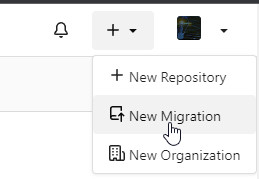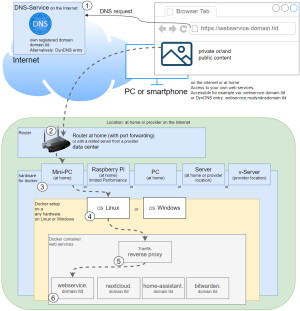Lean and fast GIT server, similar to GitHub (Docker)

Since GitLab requires a relatively large amount of memory and CPU, and is also relatively slow on my NAS, I replaced GitLab with Gitea. Gitea offers a similar web interface as GitHub, is much more economical than GitLab and is more responsive. Even though the feature set is not as high as GitLab, it is perfectly sufficient for most uses.
| Software | Gitea |
|---|---|
| GitHub | https://github.com/go-gitea/gitea |
| current version | 1.23.7 |
| found | 2025-04-11 |
Docker Basics
Docker allows applications to be launched by command in a so-called container.A container is an isolated environment independent of the operating system (OS):
When a container is first launched, Docker independently loads all the necessary sources
from the internet.
Docker can be installed on Windows, macOS or an Linux Distribution
To ensure that Gitea is can be reached securely from the Internet, I use a Let's Encrypt reverse proxy. At first I used Nginx as Reverse-Proxy, but later replaced it with Traefik. The reverse proxy provides an encrypted HTTPS connection and makes it possible to run multiple websites on one server.
Step by step Gitea and Docker including access from the internet
Hardware requirement:- Almost any hardware can be used for the Docker installation. For example, a virtual server of a provider, or for home: a Mini-PC, notebook, MAC, a NAS: QNAP, Synology or any other hardware with x68-64 architecture on which Windows or Linux can be installed.
- Own registered domain, see domain and its management.
- Cloudflare or Reverse Proxy:
- Cloudflare Tunnel Service or alternatively:
- Port forwarding and Reverse proxy with Let's Encrypt certificate
- Create and customize docker-compose.yml and .env .
- Start container and
- set up
docker-compose.yml
To start Gitea using docker compose, you can use the official Docker Gitea image and MySQL as database. Both images can be downloaded, created and started with a simple docker-compose.yml file. The file can be filled with any text editor as follows and then customized:
Filename: docker-compose.yml, Content:
services:
giteaserver:
image: gitea/gitea:1.13.6
container_name: gitea
environment:
USER_UID: '1000'
USER_GID: '1000'
DB_TYPE: 'mysql'
DB_HOST: 'giteadb:3306'
DB_NAME: 'gitea'
DB_USER: 'gitea'
DB_PASSWD: '${DB_PASSWD}'
HTTP_PORT: '80'
DISABLE_SSH: 'true'
DISABLE_REGISTRATION: 'true'
restart: always
#For direct test access, remove "#" in the following 2 lines. Call: http://localhost:83 or http://ServerIP:83
#ports:
#- "83:80"
#Labels for ReverseProxy, see: https://www.libe.net/en-traefik
labels:
- "traefik.enable=true"
- "traefik.http.routers.git.rule=Host(`git.domain.tld`)"
- "traefik.http.routers.git.entrypoints=web"
- "traefik.http.routers.git.entrypoints=websecure"
- "traefik.http.routers.git.tls.certresolver=myresolver"
- "traefik.http.services.git.loadbalancer.server.port=80"
volumes:
- gitea:/data
- /etc/timezone:/etc/timezone:ro
- /etc/localtime:/etc/localtime:ro
expose:
- "80"
giteadb:
image: mysql:5.7
restart: always
environment:
MYSQL_ROOT_PASSWORD: 'gitea'
MYSQL_USER: 'gitea'
MYSQL_PASSWORD: '${DB_PASSWD}'
MYSQL_DATABASE: 'gitea'
volumes:
- db:/var/lib/mysql
volumes:
gitea:
giteadb:
#Without using a reverse proxy (https://www.libe.net/en-traefik) the webproxy network is likely to be missing
#and the following lines can be removed or commented out. Alternatively, the network can be created with "docker network create webproxy".
networks:
default:
name: webproxy
external: trueFor direct access via IP address or localhost - even without reverse proxy, DNS or public IP - the commented out port setting can be activated for test purposes by removing “#“ in front of “ports:” and “-"83:80"“ .
For Internet access via the Traefik reverse proxy, the domain must be replaced in the labels with the previously created DNS entries (in the example: git.domain.tld).
The password for the MySQL database can be stored in an .env file:
.env
DB_PASSWD="password"The start is done from the folder of the docker-compose.yml file with the command “docker compose up”:
docker compose up -dSetup
During the initial setup on the web interface I made the following settings:
- SSH server domain* domain.tld
- Gitea base URL* https://domain.tld
To use Gitea purely as a private repository, I set the following in the setup:
- Disable registration
- Viewing requires login
- Of course, with registration disabled, an admin user must be specified in the wizard:
Administrator username, password, email address
Migration

Automatic deployment of new commits
I have solved an automatic pull of new commits using webhooks. As counterpart, I have a very simple hook server in use: github.com/ncarlier/webhookd. To make sure that the commit to a specific branch is automatically picked up by a specific Docker container, I adapted the example script as follows:
#!/bin/sh
TOKEN="???x"
# Functions
die() { echo "error: $@" 1>&2 ; exit 1; }
confDie() { echo "error: $@ Check the server configuration!" 1>&2 ; exit 2; }
debug() {
[ "$debug" = "true" ] && echo "debug: $@"
}
# Validate global configuration
[ -z "$TOKEN" ] && confDie "GITEA_TOKEN not set."
# Validate Gitea hook
sec=$(echo "$1" | jq .secret -r)
if [ $sec ]; then
[ $sec != $TOKEN ] && die "bad hook token"
else
die "empty hook token"
fi
# Validate parameters
payload=$1
payload="$(echo "$payload"|tr -d '\n')"
[ -z "$payload" ] && die "missing request payload"
payload_type=$(echo $payload | jq type -r)
[ $? != 0 ] && die "bad body format: expecting JSON"
[ ! $payload_type = "object" ] && die "bad body format: expecting JSON object but having $payload_type"
debug "received payload: $payload"
# Extract values
ref=$(echo $payload | jq .ref -r)
branch=${ref#*refs/heads/}
# Pull and Reset commited Branch
echo "branch: $branch push for $ref"
if [ $branch != "master" ]
then
docker exec $branch bash -c "git fetch origin $branch && git pull origin $branch && git reset --hard $branch"
else
echo "nothing todo: master"
fi
In the example, the current branch is passed, and a git pull is executed in the Docker container of the same name.
Conclusion
For my purposes, Gitea is currently perfectly sufficient. For larger teams or more complex deployments, however, GitLab is a good choice, see also: Hosting GIT repositories yourself: Starting GitLab as a Docker container. For easy management of Docker containers via a web interface, see also: Docker Admin Interface: Portainer Community Edition
 ({{pro_count}})
({{pro_count}})
{{percentage}} % positive
 ({{con_count}})
({{con_count}})
